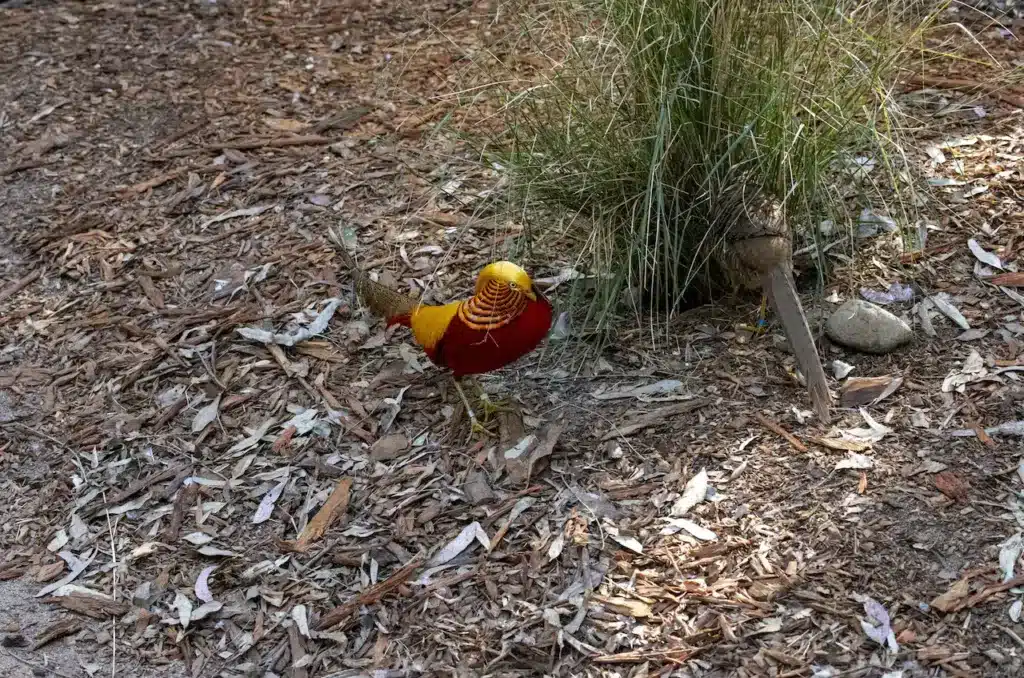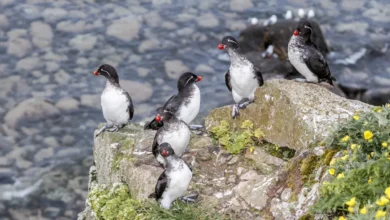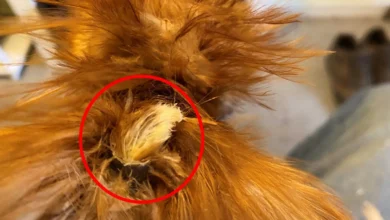The Golden Pheasant or Red Golden Pheasant is one of the best known and easiest pheasants to keep and breed in backyard aviaries. Some can become quite confiding, taking treats right from their caretaker’s hand.
These strikingly beautiful and hardy pheasants breed readily -and are, therefore, a great choice for beginners. These are small pheasants and do not require a very large aviary. They are winter hardy and able to withstand cold temperatures with little shelter. Since they are forest birds by nature, you will need to provide plenty of shade for them during the hot summer months. Direct sunlight will cause the male’s plumage to fade.
- Please refer to Housing for more information and ideas as to how to set them up.
Often Golden Pheasants are fed on mixed grains and greens. Many people also offer diets formulated for game birds as a nutritional basis.
These pheasants are extremely compatible with other types of birds. They have been raised alongside waterfowl, doves, pigeons and even peafowl. It is, however, not recommended to keep them in the same aviary with other species of pheasants.
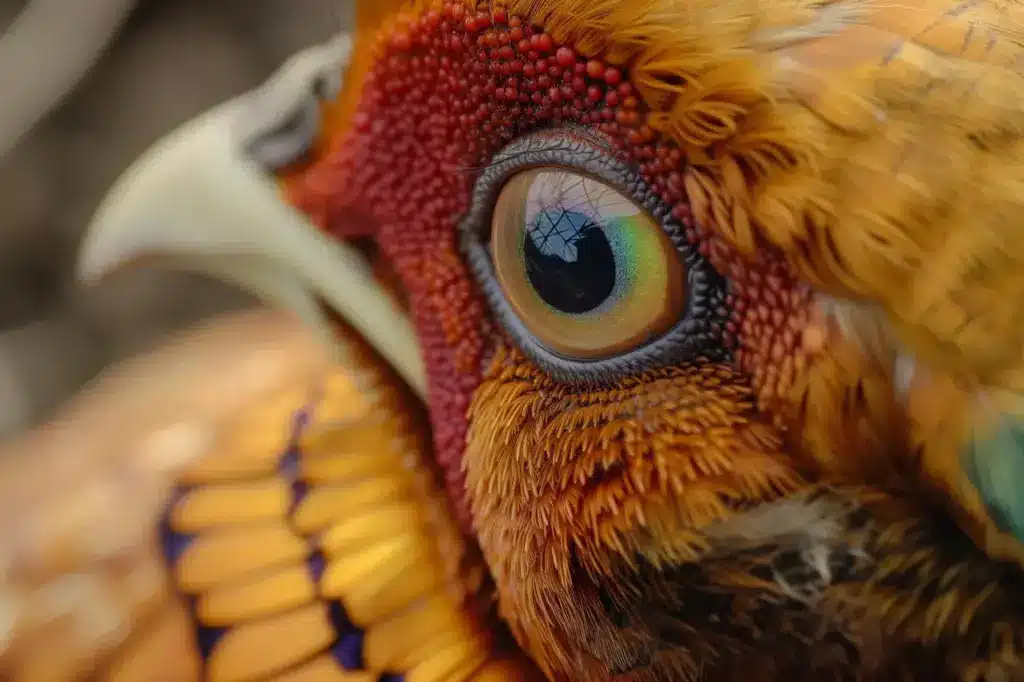
Breeding the Golden Pheasant
Although they may not have full coloration yet, male Golden Pheasants are usually sexually mature by the time they are about a year old. One fertile male can service up to four females. Courtship occurs in the spring and is fun to watch. You will notice that the males are “show-offs”, often displaying their ruff with no hens around . Although the males do not acquire their beautiful colors until their second year, first year cocks are often fertile.
The hen will begin to lay her clutch of 5 to 12 eggs in April and, if removed for incubation, another clutch will usually be deposited in June.
The hen incubates the eggs for 22 to 23 days. It has been noted that not all Golden hens have good mothering skills and they may be careless with their eggs or chicks. It is encouraged to provide as much natural surroundings as possible to encourage the hens to incubate. To avoid any problems, it is best to pair an inexperienced pheasant with one who has bred in the past to increase a successful hatch and good parenting.
The chicks are generally easy to raise and are good eaters. In fact, they are often used as role models to teach the chicks of other species to eat on their own. Golden chicks are easy to sex when very young. The color of the female’s iris is a dark brown, while the male’s is much lighter.
- More information on breeding pheasants
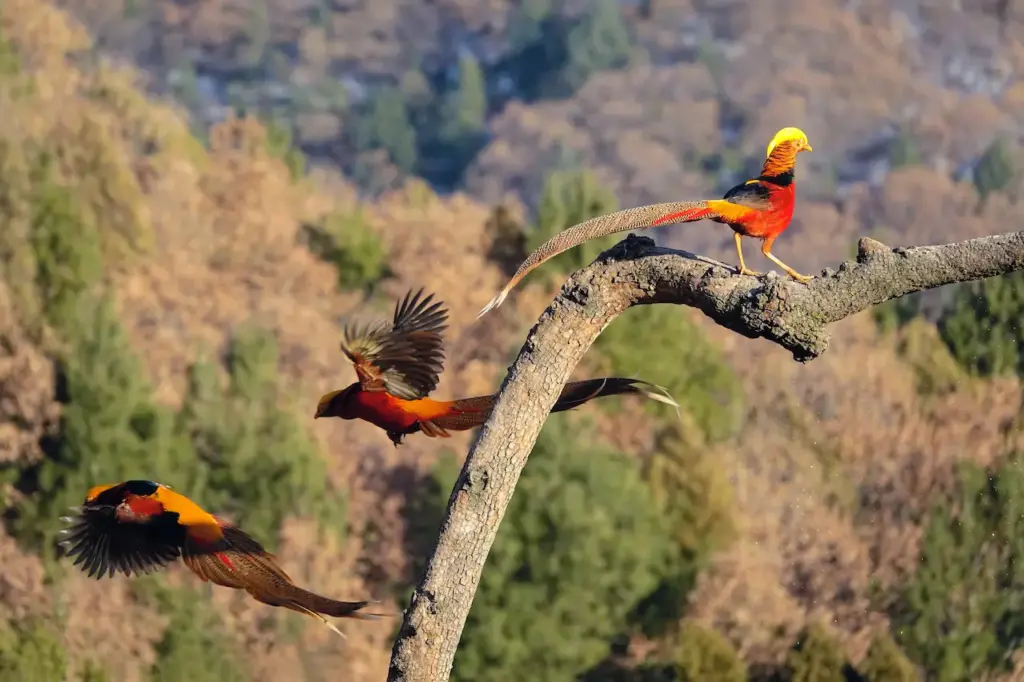
Golden Pheasant Mutations
Several interesting mutations have been developed in captivity. This being said it is opined that some of the “mutations” really are hybrids — the result of cross-breeding with the closely-related Lady Amherst pheasants, for example. Below listed are some mutations :
- Yellow Golden: Almost as common as the wild Golden in aviculture. (Refer to photo to the right.)
- Cinnamon Golden: The adult male is similar to the normal form, and at first glance, many believe that it is, but they have lost the metallic green on their back and the blue on their wings. Both have been replaced with a glossy gray. The ruff, crest and rump appear a darker yellow – almost orange. The cinnamon generally appears more glossy in appearance than the normal golden. The hens are readily distinguishable from other mutations by being an overall reddish cinnamon color with dark barring. As in the other brightly colored mutations, the male cinnamon golden’s plumage will fade in direct sunlight.
- Dark-throated Golden: The first mutation developed from the golden pheasant, however, there is recent information that disputes validity of this being a pure mutation. This dark bird was first seen in the 1860s. The adult male resembles a normal golden, but is darker with a smoky-black face and throat. The tail is also barred and not spotted as in the normal form. The hen is easily distinguishable from a normal hen. She is much darker all around with dark barring. The chicks differ from normal goldens in being dark brown with white spots. There are many indications that these birds could in fact be derived from Lady Amherst crossings.
There will always be breeders who will claim to have bred a new mutation, which in reality turns out to be a hybrid. As mutations sell for more money and mutations are difficult to breed (unless you start with birds that already carry the gene) — it is often a financial consideration for unethical breeders to be less than truthful about the pureness of their stock.
It is the goal in aviculture to keep species pure. To this end, be careful when considering purchasing a so-called “new mutation” — request photos and as much information as possible about the development of this “mutation.”
Although Golden Pheasant and Lady Amherst Pheasant crossbreeds are fertile, many other Golden Pheasant hybrids are not fertile. In some instances, only male hybrids are fertile. Regardless, many people believe it is important only to breed pure Golden Pheasants and to strictly document and separate hybrids when they are desired.
With careful observation of ADULT Golden Pheasants, you will be able to see the signs of a cross-breeding. The male will have the following if crossed:
- Unusually large for a pure Golden Pheasant
- You may be able to see traces of red in the crest besides that at the very tip
- Traces of green in the breast
- Red in the lower back or rump
- A Golden hen should be small, also with yellow legs and no tinge of red in the crown. Immature goldens are much lighter in the overall color when compared to an Amherst, and of course, the legs will be yellow
